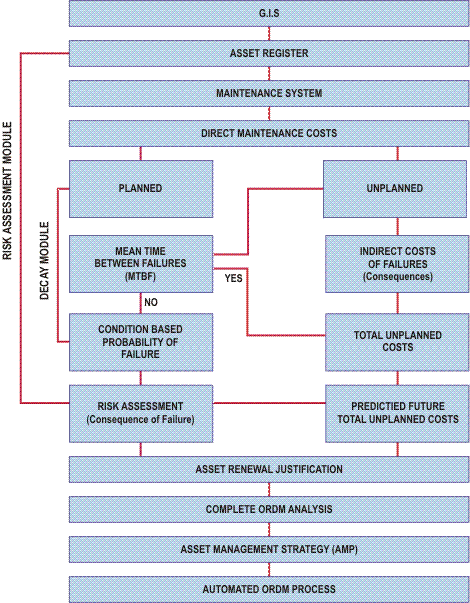Automating the Process
This process can be substantially automated. By adopting this approach organizations can reduce the cost of analysis. By optimizing this cost additional effort can be directed to the technical smarts or effectiveness effort that is necessary in managing assets.

The key elements or modules that organizations need to consider implementing are:
- Maintenance management system. Capable of recording or outputting:
- Planned activities and costs
- Unplanned activities and costs
- Cause of failure
- Activity used to carry out work required
- Ancillary indirect costs associated with the failure
- Mean time between failures.
- Condition recording system.
- Predictive condition decay modeling modules, including matching probability of failure curves.
- Risk assessment module.
- ORDM analysis module.
The inputs and processes necessary for the ORDM process are shown below:
Maintenance costs
- Planned:
- Servicing tasks
- Preventive tasks
- Unplanned:
- Schedulable corrective maintenance (CM).
- Emergency
- Predictive (condition based)
- Direct cost of failure:
- Authority assets
- Labor
- Plant and equipment
- Materials
- Non authority assets
- Other authority property/assets
- Private property/assets
- Legal costs
- Other costs of failure
- Indirect costs of failure:
- Impacts on customers
- No. of customers affected
- % Deviation from contracted level of service
- Length of time of service deviation/failure
- Complete economic value of these consequences of failures.
- Cause of failure/expenditure (extract erroneous data) for example:
- Operator errors
- Accidents
- System inadequacy (capacity)
- Asset reliability
- Structural integrity (condition)
- Cost of activities used to overcome failure or complete planned tasks for example:
- Type of procedure followed
- Labor tasks involved
- Plant/equipment used
- Type of procedure followed
- Materials, spare parts used.
- Non-critical assets (low consequence/multiple failure):
- Determine mean time between failure
- Determine the customers' intolerance to multiple failures
- Assess average costs of failure (to date)
- Project these costs forward (cash flow)
- Determine NPV of these predicted costs
- Assess against estimated costs to overcome the cause or causes of failure
- Determine whether renewal is justified and when likely
- Complete restricted ORDM analysis to level justified by investment evaluation guidelines
- Add program to TAMP inputs.
- Critical assets (consequence of failure approaches or exceeds the cost of renewal):
- Assess current condition
- Determine effective or residual life
- Establish appropriate decay curve
- Establish related probability of failure curve
- Predict future failure date (100%)
- Model distribution of failure (annual)
- Assess future risk exposure
- Assess NPV of these predicted costs
- Assess against cost to overcome the cause or causes of failure
- Determine likely date when renewal is likely to be justified
- Complete detailed ORDM analysis to level justified by investment evaluation guidelines
- Add program to TAMP inputs.
Specialist Modules Required for AAM Micro / Mainframe Interfaces
Choosing The Right Option
Optimized Renewal Decision Making
ASSET ID: | . |
ASSET DESCRIPTION: | . |
EFFECTIVE LIFE (yrs): | REPLACEMENT COST ($): |
OPP. COST OF CAPITAL (%): | . |
NO. OF TREATMENT OPTIONS: | . |
OPTION NO.: | YEAR REQUIRED: |
OPTION DESCRIPTION: | . |
TREATMENT COST ($) | EFFECTIVENESS (yrs): |
INPUT/ADD BENEFITS EFFECTED AND BENEFITS CODE: |
TYPE | CODE |
Constant | 1 |
Uniformly Distributed | 2 |
Variable | 3 (if '3' input the actual % effectiveness over the years being assessed) |
BENEFITS | EXISTING ($) | % EFFECTIVE (Initial) | BENEFITS CODE |
Reduction in O&M Cost | . | . | . |
Improved Level of Service (Premium) | . | . | . |
Improved Production | . | . | . |
Reduction in Potential Risk Exposure | . | . | . |
Deferred Replacement Program | . | . | . |
Other Benefits (Please Add) | . | . | . |